![]()
PART 1 Season-starting Memories
As the new skating season swings into action, many Alumni are reminded from years gone by of the thrills and fears experienced at the start of their own competitive seasons. Whether Athlete, Judge, Coach, Volunteer or Hall of Famer, every memory is golden and demonstrates the richness that is part of our individual skating stories.
In this edition of the Alumni blog, enjoy Part 1 of these “season-starting” memories. (Part 2 in the next edition.)
 Ann Shaw (1959 & 1960 Canadian Senior Dance silver medalist, National, International and Olympic Judge, ISU Honorary member, Skate Canada Hall of Fame member)
Ann Shaw (1959 & 1960 Canadian Senior Dance silver medalist, National, International and Olympic Judge, ISU Honorary member, Skate Canada Hall of Fame member)
“What I remember so fondly are the days when Barbara Graham was Technical Director and all international dance judges, competitors and coaches started their season at the Dance Week in London Ontario.
The judges had the benefit of watching all the top teams performing the compulsories for the year with all the top coaches on the ice as well.
We all attended clinics on any new dances, such as the Tango Romantica (with all of us either on ice or on the ballroom floor being taught the steps) with Bernie Ford or Roy Bradshaw and with the dancers assisting and partnering us.
Along with the coaches, we had seminars on the then Original Set Pattern Dance Rhythms for the year (now the Rhythm Dance) – I well remember judge Dennis MacFarlane doing his mean Rhumba and expounding with amazing knowledge on possible music selections.
The dancers of course, along with the on-ice component, had their medical testing to set up the year which was always a bit intimidating for them.
The wonderful thing was – this was all done in June so we all really had an early kick-off of the year’s activities. And it was judges, coaches and dancers all rapping together with lots of laughs and practical jokes.
It was an amazing experience for everyone!”
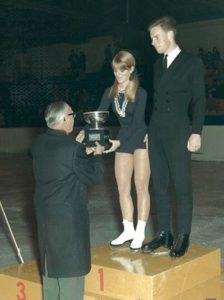 Louise and Barry Soper (1971-1974 Canadian Ice Dance Champions, World team members)
Louise and Barry Soper (1971-1974 Canadian Ice Dance Champions, World team members)
Here’s a little trivia from our memory banks.
We also remember the CFSA (Canadian Figure Skating Association) organizing national ice dance clinics and, to my recollection, Louise & I attended the first such clinic – in London, ON. We think It was the summer of 1973 (?) when Russian ice dance coach Elena Tchaikovskaya, coach of World Champions Ljudmilla Pakhomova & Alexandr Gorshkov, was invited by the CFSA (through Barbara Graham) to lead this inaugural National Ice Dance Seminar in which we and a couple of dozen other dance teams participated in this clinic. Three of the primary features were off-ice training regimens and on-ice stroking and skating solo to improve edge work, etc.
Our timing was such that we had the good fortune/misfortune of having to compete against the originators of these dances…when they competed with them:
- Yankee Polka in 1971 at Worlds in Lyon, France – inventors Judy Schwomeyer & James Sladky
- Ravensberger Waltz in 1973 at Worlds in Bratislava, Czechoslovakia – inventors Angelika & Erich Buck
- Tango Romantica in 1974 at Worlds in Munich, West Germany – inventors Ljudmilla Pakhomova, Alexandr Gorshkov
 Roy Bradshaw (Canadian, World & Olympic Dance Coach)
Roy Bradshaw (Canadian, World & Olympic Dance Coach)
“From a coach’s point of view, I recall many of my dancers who were there at the ice dance training camps – to name a few: Karen & Rod Garossino, Michael Farrington, Scott Chalmers, and Joanne Borlase.
I particularly remember the great comradery between the dance coaches with no bickering: this togetherness eventually evolved into the Canadian Foundation of Dancing where our dance coaches were team teaching for a number of years in Richmond Hill. (I also remember that Jean Westwood’s cigarette ash burned a hole in my track suit! Yes – she smoked on the ice!)
Coaches included Bernie Ford, Marijane Stong, Paul Mac, John Briscoe, and June Thorlackson. A fantastic addition was that Barbara Graham brought in some world leaders to help at the camp as well – Courtney Jones and Bobby Thompson, Kristina Regoczy and her partner Andrew Sallay among other famous international coaches.”
![]()
Canada Ice Dance Theatre: The Move to Vancouver – Volume 3
Written by Ron Vincent
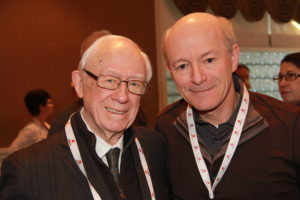
Re-establishment of Canada Ice Dance Theatre (CIDT) in 1982, now in Vancouver, was hard slogging. Frank Nowosad and I were supporting the organization’s activities through incomes from regular teaching. But we did at least have a company of about twelve young coaches who were eager to take part, and they paid the ice costs for regular early morning classes.
A Company warm-up to a Philip Glass composition was developed mainly by Frank and this group of skaters, which we often used as a performance piece. It consists of positions of lyrical beauty, jumps and spins in both directions, and intricate, rhythmic footwork. Additional to this foundational work were Annie’s Edges exercises, popular with both amateur and professional skaters who employed them to keep their edges strong, and to get or stay in shape.
Early in our move to Vancouver, CIDT collaborated with the Kitsilano Figure Skating Club in a show that participants still talk about. Adult skaters especially recall the comedy, “At the Awful Falafel,” which showcased their comic acting skills as well as their skating.
At the West End Community Centre, with on-ice bleachers on one side and on both ends, the small rink was further reduced. The intimacy this setting provided was important in giving a greater expressive dimension to performance, hard to achieve in a large hockey rink. Event Producer, Mark Wyatt observed, “This is the way skating should be viewed.”
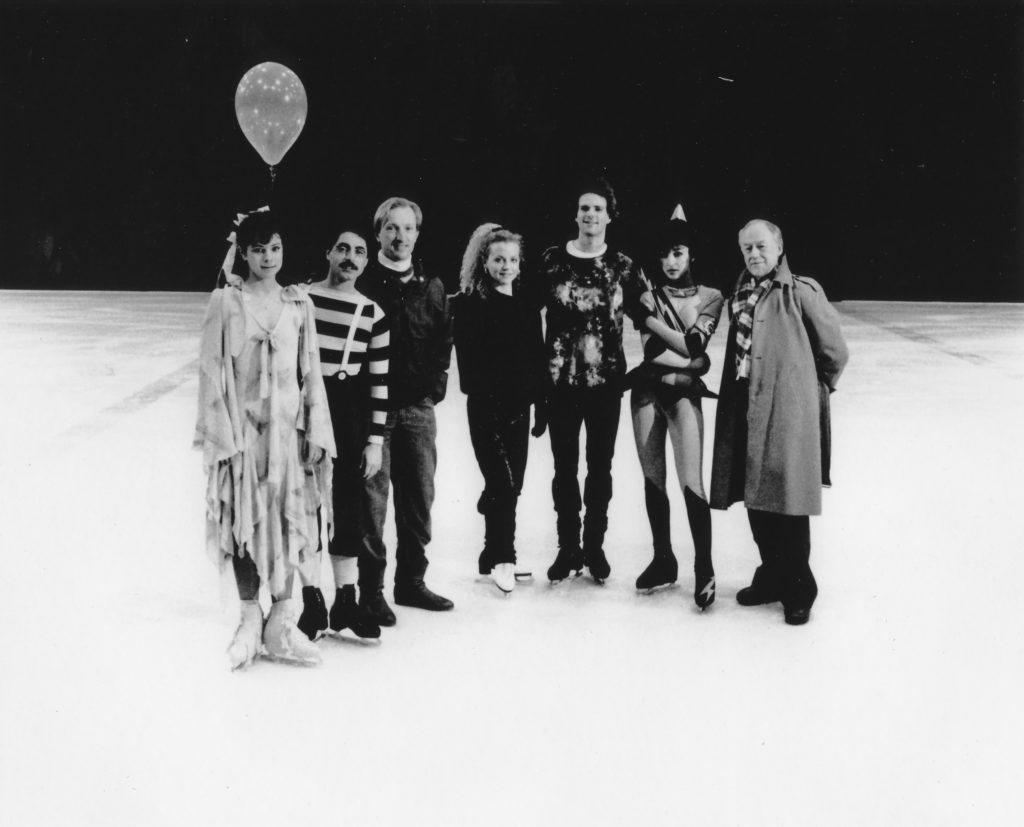
Pieces developed at the West End Community Centre saw showings at several of Vancouver’s First Night Celebrations: at Robson Square, the Pacific National Exhibition’s Agrodome, and at the North Vancouver Community Centre. These performances were free to the public and CIDT was paid an honorarium. As a public service, we also presented unpaid performances at venues provided by the West End and Robson Square.
The organization began to receive funds from the Lottery Corporation of BC for projects deemed of community value, and the character of the pieces Frank and I produced at the West End found audiences willing to brave the cold to see them. With an advanced cast of performers, the skating was of a high caliber. “Dress warmly!” the posters advised.
CIDT took part in two editions of Winterfest, counterpart to the well-established children’s Summer Festival. Funded by Heritage Canada the first year, it was a collaboration with the BC Section of the then-called Canadian Figure Skating Association and was a combination of BC’s top competitive skaters, national champions and CIDT skaters, many of the latter being experienced professional performers.
In all the years together in CIDT, choreographically Frank and I collaborated only once; it was for the second edition of “Winterfest.”
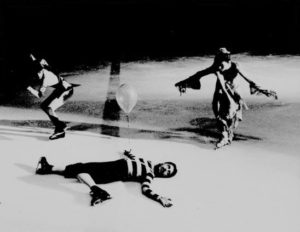
I adapted a commedia dell’ arte piece previously co-composed with a cast of advanced performers, and Frank interjected short sections of modernity into the otherwise classical piece that were like flash-forwards. It worked well, but most of the audience, largely children with their parents, probably saw only the colorfulness of Carolyne Curran Knight’s costumes and the curious actions of the skaters. The Producer observed that it was “too good,” for a children’s show, but also said that his adult daughter loved it.
Since Frank’s death in 1993, without his share in developing the repertoire and helping with administrative tasks, the following years were heavier going, and I sorely missed him and our discussions.
I introduced a school series “Story-Telling on Ice,” based on several of Robert Munsch’s children’s stories, from which by his permission I adapted and created dialogue. Performances were given in Vancouver, Richmond, Abbotsford, Maple Ridge and Victoria with letters of appreciation received from the schools.
We continued to produce shows both for general audiences and for children, and Mark Wyatt’s Amway Japan show at BC Place Stadium was particularly gratifying. The space was transformed into a winter scene given a sense of great depth through a clever transition of real fir trees, snow-laden, proceeding forward from their painted counterparts on a huge mountain landscape.
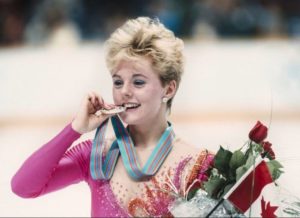 With an augmented cast headlined by Elizabeth Manley, the show, on a 40 X 60 foot raised ice-surface, was classic Canadiana, and as the after-dinner entertainment, with lighting “to die for,” it was met with much applause. Frank, no longer with us, was nevertheless represented by the inclusion of his piece, “Forest.” It was a classy show and it received a nomination for the “Best Entertainment at an Event in North America in 1995.”
With an augmented cast headlined by Elizabeth Manley, the show, on a 40 X 60 foot raised ice-surface, was classic Canadiana, and as the after-dinner entertainment, with lighting “to die for,” it was met with much applause. Frank, no longer with us, was nevertheless represented by the inclusion of his piece, “Forest.” It was a classy show and it received a nomination for the “Best Entertainment at an Event in North America in 1995.”
(Alumni Committee) Who were these visionaries who brought the CIDT to life? Learn more about them, their ground-breaking creativity and their greater influence on skating in Ron’s final volume in the next edition of the Alumni Blog.
![]()
 As a young four year-old Donald McPherson began skating at the Stratford Figure Skating Club and went on to become an exceptional athlete and claim a number of firsts in the history of figure skating. Competing at the senior level he claimed runner-up honors at the 1960, ’61 and ’62 Canadian Championships. In 1963 he became the first man to claim the Canadian, North American and World Senior Men’s titles all in one year without having won any of them previously. Donald was the first man in world championships to jump from fourth to first place and, having just turned 18 years of age, the youngest man ever to win the world title. Retiring from amateur competition in 1963 and overcoming enormous physical hardships, he went on to star with “Holiday on Ice” in Europe for 10 years. In 1965, he won the Men’s World Professional Championships. Donald is also a member of the Skate Canada Hall of Fame.
As a young four year-old Donald McPherson began skating at the Stratford Figure Skating Club and went on to become an exceptional athlete and claim a number of firsts in the history of figure skating. Competing at the senior level he claimed runner-up honors at the 1960, ’61 and ’62 Canadian Championships. In 1963 he became the first man to claim the Canadian, North American and World Senior Men’s titles all in one year without having won any of them previously. Donald was the first man in world championships to jump from fourth to first place and, having just turned 18 years of age, the youngest man ever to win the world title. Retiring from amateur competition in 1963 and overcoming enormous physical hardships, he went on to star with “Holiday on Ice” in Europe for 10 years. In 1965, he won the Men’s World Professional Championships. Donald is also a member of the Skate Canada Hall of Fame.
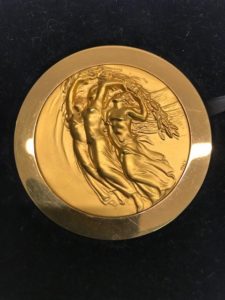
![]()
December 2018
Only a few left…

January 2019

![]()
We’d love to hear from you! Today staying in touch is easier than ever!
E-mail us your stories, photos, thoughts, suggestions and questions. We can’t guarantee we’ll print each one however we will certainly read every word and in the case of questions, find answers to them all.
Contact Celina Stipanic, Alumni and Fund Development Manager at [email protected]
